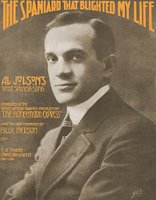Let's go on a reconstructed walking tour of Bucktown in 1907. The area took in about six square blocks: from Front Street to East Third, and from Perry to the Arsenal Bridge annd the main line of the Rock Island Lines. From the vantage point of a westbound train or by foot, the area consisted of low-lying buildings, warehouses, small shops, tenement houses and saloons. The visitor could see hillside mansions beyond his line of vision and below the elevated tracks, some females might be posing in the windows or perhaps waving as the train slowed down, stopping first at the Burtis House at Perry and Fourth. Alighting from the train, our walk starts in a southern direction.
At the heart of the district was Brick Munro's dance hall.
At the peak of it's popularity,more than 1,000 people a night would stop in and have a beer while listening to the singing waiters on a small stage. This platform was used "by the professional vaudeville performers who would frequently do their turns on their turns on these slight stages ....As a result, many people who normally would not have felt free to visit the district....could rationalize that they were just going to watch the shows." The result was that Brick Munro's weekly receipts topped $2,500.
In reality, Brick's was a dancing pavilion and saloon. Floyd Dell...Davenport poet and socialist, described it from first hand experience. Herewith is his report:
A wire fence divides a row of seats and tables roofed by a trellis of vines from the dancing floor, with it's whitewashed pillars, wall and ceiling and in one corner bar.
The liquor was only part of the operation.
Tables and chairs range the sides of the room at which sit well dressed young men and girls. Over in the shade stands a special policeman , whose duty it is to see that the lads and lassies who have had too much and are getting loud leave before they have a chance to start a rough house. In the saloon the barkeep is doing a rushing business.
One possible legacy of the departed Bucktown was the introduction of syncopated music such as ragtime and jazz down by the riverfront. Many of the saloons had mechanical pianos which played for a nickle, but Brick's, the Standard and perhaps a few other places, had musicians who played. In my opinion, this could very well be the inspiration for the future coronet virtuoso, Bix Beiderbeck, who would have been a teenager when the district was disappearing. From the beginning, syncopated music was condemned as immoral and quite logically associated with with it's surroundings in bordellos down in New Orleans. As the black musicians slowly moved to Chicago, they probably stopped off in places like Davenport where the young Bix was stimulated into musical experiments. A contemporary opinion was that "jazz music is the indecent story syncopated and counterpointed. Like the improper anecdote, also, in its youth, it was listened to behind closed doors and drawn curtains, but like all vice, it grew bolder until it dared decent surroundings and there wass tolerated because of it's oddity." By 1917 the first black jazz musicians were playing in Chicago and Bix had decided that music would be his life.

